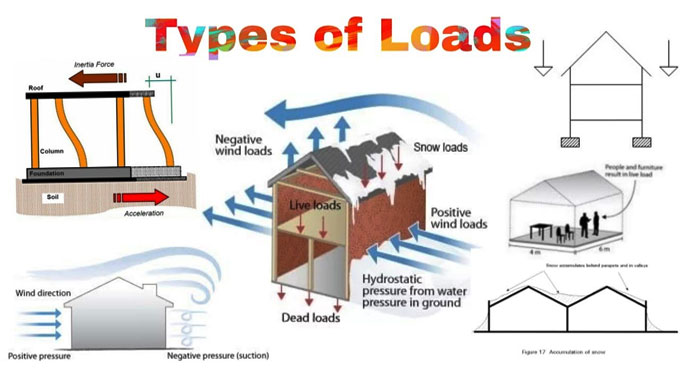Structure load is a term that refers to the weight of all objects on an object, such as a building or bridge. The load on a structure can be divided into two categories: ‘vertical’ and ‘horizontal’. Vertical loads include gravity, wind, earthquakes, and the weight of floors above. Horizontal loads are created by occupants (live or dead), furniture, equipment, snow, and rain, etc. This blog post explains types of loads in more detail to help you understand how they affect your building design choices.
These loads are also categorized into static and dynamic loads. Static load occurs as a result of gravity. On the other hand, dynamic load can be caused by wind, earthquakes, or an object hitting the building.
One of the most challenging aspects of structural engineering is determining how a structure will react to loads. The type of load on a structure largely depends on its location and what it’s being used for. For example, buildings in earthquake zones need to be designed with seismic considerations in mind. Those that are near highways must account for traffic loading. Also, the tall buildings require additional vertical forces due to natural phenomena like wind gusts which could cause them to topple over if not accounted for during design phases.
This article is designed to help business owners, investors, and civil engineers understand the basic knowledge of loads. Adhering to the proper loading procedures and specifications can often be confusing. However, by understanding these different types of loads will allow you to make better decisions about your building’s design and construction.
Dead Load
Dead load is the weight of all the structure which supports a building. The dead load includes items like walls, ceilings, floors, and other structural components. Dead loads are not limited to just those portions of a building that make contact with the ground but also include any number of vertical elements in between such as columns or beams. This type of loading can be more accurately calculated than live loads because these objects do not move around.
The taller your structure becomes, the more stress there will be on its foundation and surrounding structures. Since they have to support an increasing amount of weight with less surface area for distribution across their base.
Live Load
The live load includes everything that contributes to the weight of a structure, including people, furniture (and other contents), and any debris that could be on the floor. It’s important to know how much live load your construction site will have so you can plan for it properly in advance. All buildings, whether they are residences or businesses, have an imposed weight limit. This is called the Live Load. The live load can be quite different depending on what type of building it is but the general idea is that a building should not exceed its own maximum capacity for how much weight it could hold and still sustain structural integrity. When working with engineers who design structures like bridges and buildings, knowing their live load limits can help you plan accordingly to ensure your company’s structure will remain standing.

Wind Load
Wind load is defined as the pressure exerted on a structure by the wind. The more difficult it is for you to get around in your area, the higher your wind load will be. Wind speed and terrain are both factors that can change how much stress there is on a building. You need to know what type of soil you have, too, because different types of soil can hold up better than others against high winds.
It is an important factor when designing a structure for the outdoors. The force of the wind on buildings or other structures can be significant, and it’s important to design with this in mind. However, not all structures are designed for wind loading- specifically those that will never see high winds such as residential homes. In these instances, designers must take into account more benign forces like rain or snow loads which may have similar effects on a building but are less intense than wind loading.
Snow Load
Snow load is the weight of snow on a roof that can put pressure and stress on building structures. The amount of snow to be removed from roofs when we have heavy snowstorms is one way in which engineers predict how much weight our buildings will bear. In order to understand how much it weighs, it’s important to know how deep snow can get. If you compress and compacted snow as hard as possible, then it will have an average density of 25 pounds per cubic foot. The USGS estimates that one inch of snow has about five pounds per square foot! This means that if you are driving in 10 inches of heavy wet slushy ice-covered snow, your car would be carrying 50 tons (roughly 110,000 lbs).
Formula to calculate minimum snow load is:
S=μ S0
Where
- S= Design snow load on plan area of the roof.
- μ= Shape coefficient
- S0= Ground snow load
Earthquake Load
Earthquakes are natural disasters that can strike at any time, anywhere. Earthquakes cause shaking and vibrations in the earth’s surface, which can damage buildings, bridges, and other structures. The largest earthquake ever recorded was a magnitude 9.5 event near Chile on May 22, 1960. This epicenter earthquake release energy equivalent to about 1 billion tons of TNT explosives! But what is worse than large earthquakes? Smaller ones! A smaller but more frequent quake will do just as much damage as a larger one because they happen more often. These small quakes occur every day around the world and can be tracked by seismographs or even satellites orbiting Earth from space! Seismographs measure ground motions caused by these events while satellites detect radiation emitted from them.
Since the response of the structure to ground movement is proportional to the weight of the building and the intensity of ground motion, only those structures that are strongly built and stand on soil that won’t slide will be safe in an earthquake.
Contact Tameerkaro for your Strong Building Construction
Whether you’re designing a new building or doing renovations on an existing one, understanding the different types of loads your structure will have to support can help save time and money in the long run by preventing future structural issues.
Equipped with the latest methodology and experienced engineers, Tameerkaro is a construction company that is known for constructing buildings that are durable and resistant to natural disasters. For the construction of strong structures from low to high-rise residential, commercial, and industrial facilities call 0300-0556666 or visit our website to get free estimate.

